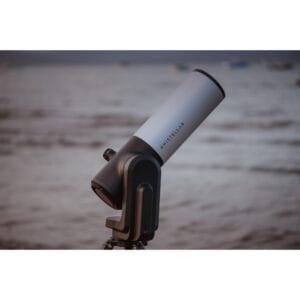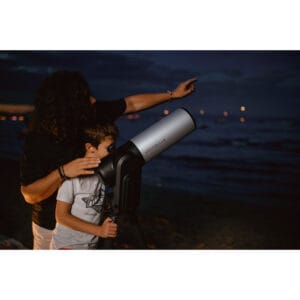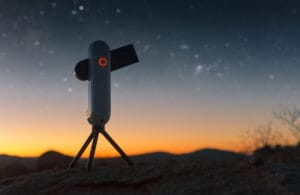We sometimes get the question ‘what is a telescope?’ Since the early seventeenth century, telescopes have been essential in the stargazer’s toolkit. They help you see craters on the moon, admire Saturn’s rings, or observe distant galaxies. But how does such an instrument actually work? In this blog post, we explain in an accessible way how a telescope collects and magnifies light and what types exist.
Why Do You Need a Telescope?
First of all, why would you want to buy a telescope? Well, without a telescope, the universe remains superficial. You see a few bright dots but miss the details and depth that make the universe so fascinating. With a telescope, you bring space closer both literally and figuratively.
A telescope isn’t a luxury (or maybe it’s an affordable luxury?), but a gateway to wonder. It addresses two fundamental limitations of the human eye:
- Collecting light: the larger the lens or mirror, the more light is captured. This allows you to see objects that are normally invisible, such as nebulae or Jupiter’s moons.
- Magnifying image: distant celestial bodies appear closer, allowing you to distinguish craters, rings, or cloud bands.
So you’re not just buying a scope but investing in an experience. A telescope makes it possible to spot planets yourself, study the moon in detail, and discover deep star clusters or nebulae. It’s an unforgettable way for both young and old to get to know the universe.

What is a Telescope and What Does it Do?
A telescope doesn’t just magnify objects – it primarily collects light. The more light that enters, the more details you see. After all, stars and planets are extremely far away and emit little light. A telescope makes that light visible and magnifies the image, allowing you to see things that remain invisible to the naked eye.
There are roughly two types of telescopes:
- Lens telescopes (refractors) – use glass lenses
- Mirror telescopes (reflectors) – use curved mirrors
Both systems have their advantages, which we’ll discuss shortly.
The Basics: Focal Length and Aperture
Two numbers are crucial for a telescope:
- Aperture (in mm) often the first number (for example Celestron Starsense explorer 114/1000 – where 114 is the aperture in mm) how large is the lens or mirror? More aperture means more light, thus more detail.
- Focal length (in mm) – determines how long the light path is in the telescope. This subsequently determines the magnification.
Calculate the magnification like this: Magnification = telescope focal length ÷ eyepiece focal length
So a telescope with 650 mm focal length and a 10 mm eyepiece provides 65x magnification.
But note: more magnification doesn’t automatically mean a better image. Often, less is more. A sharp image at 120x is more valuable than a blurry spot at 300x. Maximum useful magnification is lens aperture x 2. So for example, if a telescope has a lens aperture of 130, the max. magnification is 260. Anything above that creates a blurry image.
Refractor versus Reflector
What’s the difference between these two telescope types?
Refractor (Lens Telescope)
- Light passes through a glass lens
- Seals off light directly: low maintenance
- Good for moon and planets
- Often more expensive per millimeter aperture
- Compact and user-friendly
Reflector (Mirror Telescope)
- Light is reflected by a curved mirror
- More aperture for less money
- Good for deep-sky objects (nebulae, galaxies)
- You usually look from the side, via a mirror
- Needs occasional collimation (alignment of mirrors)
There are also combination systems like Maksutov-Cassegrains or Schmidt-Cassegrains, but these are less common for absolute beginners.
How Does a Telescope Work Optically?
When light from a distant star or planet enters your telescope, something special happens.
- Refractors use a convex lens to refract and concentrate parallel light rays at a focal point. After the focal point, the light diverges again, and the eyepiece (the lens you look through) bends this light so you see a magnified, upright image.
- Reflectors use a concave mirror to concentrate the light. A smaller second mirror directs the light sideways to the eyepiece. So you look from the side.
For both types: the larger the aperture (lens or mirror), the more light and thus more detail. However, the image quality is also affected by the atmosphere.
The Influence of the Atmosphere
A telescope on Earth looks through a thick layer of air. That layer moves continuously – with temperature differences, moisture, and turbulence. This causes:
- Seeing: the stability of the air. Poor seeing gives a dancing, blurry image. You can often check this via websites like clearoutside.com.
- Transparency: the clarity of the air. Haze, moisture, or light pollution reduce contrast.
Stars that twinkle heavily = poor seeing. Can you see many stars of the Little Dipper? Then transparency is good.
That’s why professional telescopes are often located on high mountains or even in space. The Hubble Space Telescope, for example, hangs outside the atmosphere and can therefore make extremely sharp images, down to the level of seeing a firefly in Tokyo from New York.
What Do You See through a Telescope?
This depends on the combination of aperture, magnification, and conditions. With a good beginner’s scope, you can see:
✓ Craters and details on the moon
✓ The rings of Saturn
✓ Cloud bands on Jupiter and its four largest moons
✓ The phases of Venus
✓ And under good conditions: star clusters and nebulae
Note: you won’t see colorful Hubble images, but subtle grayscales or light yellow/orange details. Visual observing is different from astrophotography.
Common Mistakes
- Buying a telescope with “800x magnification” on the box. Nonsense. No beginner’s scope provides a usable image at such magnifications.
- Cheap toy telescopes: these often cause frustration due to poor optics and unstable tripods.
- Lack of patience: learning to focus and find objects takes practice.
Which Telescope Do We Recommend for Beginners?
A few excellent choices from our assortment:
- Celestron StarSense Explorer 114AZ – User-friendly, works with your smartphone
- Sky-Watcher Explorer 130P AZ-GTe – Electronically controlled, excellent optics
- Sky-Watcher Heritage 100P – Compact, lightweight and powerful for its size
- Bresser Messier 130/650 Dobson – Affordable, visually powerful and stable
👉 Check out our beginner’s guide for an overview of the best entry-level models.
Need Help Choosing?
Still unsure which telescope is best for you? Ask AstroBob, our smart chatbot in the bottom right of the site. Or send us a message/call us and we’ll be happy to help you decide.





